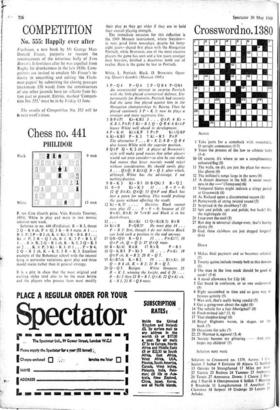Chess no. 441
PHILIDOR
Black
9 men
13 men
P. ten Cate (fourth prize, Vida Rotaria Tourney, 1956). White to play and mate in two moves; solution next week.
Solution to no. 440 (Fridlizius): R - B 3, threat 2 Q - R 4 ch, P x Q; 3 R - B 4 mate. A 1 . B x P; 2 P - B 3 ch, K X Kt; 3 R - B 6. B 1 ... Kt x P; 2 R - Q 3 ch, B x R; 3 P - B 3. C 1 . . . B x R; 2 Q-Rlch,K-K 5; 3 Q-K 5 or 2 ...K xP; 3 Kt-K 3.D 1 ...P-B 4;
2 Q-R 1 ch,K-K 5; 3 R-K 3.Excellent example of the Bohemian school with the interest lying in particular variations, quiet play and three model mates rather than in general strategy.
It is a pity in chess that the most original and exciting styles tend also to be the most brittle and the players who possess them must modify
their play as they get older if they are to hold their overall playing strength.
The immediate occasion for this reflection is the 1969 Monaco tournament, where Smyslov- in very good form nowadays, despite his forty- eight years—shared first place with the Hungarian Portisch, while Bronstein, one of the most creative players the game has seen and a few years younger than Smyslov, finished a disastrous tenth out of twelve. Here is the game he lost to Portisch.
White, L. Portisch. Black, D. Bronstein. Open- ing. Queen's Gambit. (Monaco 1969.) 1 P-Q 4 P-Q 4 2 P-QB 4 P-QB4 An unsuccessful attempt to surprise Portisch with the little-played symmetrical defence. Un- fortunately for Bronstein. Portisch had recently had the same line played against him in the Hungarian championships by Barcza. Then he played cautiously 3 P - K 3; now he plays a stronger and more aggressive line.
3 B PxP! Kt-KB3 3 . . . QXP; 4 Kt - K B 3, PXP; 5 Kt - B 3,Q - Q R 4: 6 KtxP leaves White well ahead in development.
4 P-K 4! KtxKP 5 PxP KtxQ BP 6 Kt-KB3 P - K 3 7 Kt - B 3 PxP
The alternative 7 . . . B - K 2; 8 B - Q B 4 also leaves White with the superior position.
8 QxP Q - K 2 ch? A player of Bronstein's style will make good moves that other players would not even consider—so also he can make bad moves that lesser mortals would reject without consideration. He should surely play 8. . . QXQ: 9 KtXQ, B - Q 3, after which, although White has the advantage, I see nothing decisive.
9 B - K 3 Kt - B 3 10 B-QKt 5 B - Q 2 11 0 - 0 Kt - K 3 II . . . 0 - 0 -0; 12 Q BXKI, QXQ; 13 QXP and Black has lost a pawn for nothing. This would prolong the game without affecting the result.
12 Kt - K 5! . . . . Decisive. Black cannot now play 12 . . . 0 - 0 - 0; because of 13 B)< Kt, B X B; 14 NIX 131 and Black is in his death-throes.
12 ... KtxKt 13 QxKt(K 5) BxB
14 KtxB P-QR3? He must play 14 . . .
P - B 3; first, though I do not believe Black can hold such a position in the end anyway.
15 QR-Q11 R -Q 1 15 . . . PxKt??; 16 QxP ch, Q - Q 2;- 17 QxQ mate.
16 B- Kt 6! RxR 17 RxR P - B 3
18 Q-K B5 P- Kt 3 18. . . PxKt,- 19 QxP ch, K - B 2; 20 R - Q 7.
19 Kt-B7ch K - B 2 19 . . . Ktx Kt; 20
Q - B 8 ch, K - B 2; 21 R - Q 7.
20 Q - Q 5 Resigns White threatens 21 R - K I, winning the knight, and if 20 . . . B - Kt 2 then 21 B - B 5, QxB; 22 Qx Kt ch, K - B 1; 23 R - Q 8 mate.


































 Previous page
Previous page